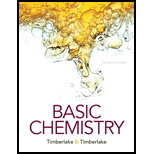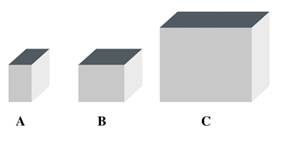
Basic Chemistry (5th Edition)
5th Edition
ISBN: 9780134138046
Author: Karen C. Timberlake
Publisher: PEARSON
expand_more
expand_more
format_list_bulleted
Concept explainers
Textbook Question
Chapter 2, Problem 2.101UTC
Consider the following solids. The solids A, B, and C represent aluminum, gold, and silver. If each has a mass of 10.0 g, what is the density of each solid? (2.7)
Density of aluminum = 2.70 g/mL
Density of gold = 19.3 g/mL
Density of silver = 10.5 g/mL

Expert Solution & Answer
Want to see the full answer?
Check out a sample textbook solution
Students have asked these similar questions
Draw the formula of the compound 4-cyclohexyl butanamide?
What is the formula of the compound 3-isopropylcyclopentane-1-carbonyl chloride?
Indicate the products of the reaction between CH3COCH2COONa (Sodium acetoacetate) and BrCH2COOC2H5
Chapter 2 Solutions
Basic Chemistry (5th Edition)
Ch. 2.1 - Give the abbreviation for each of the following:...Ch. 2.1 - Give the abbreviation for each of the following:...Ch. 2.1 - Prob. 2.3QAPCh. 2.1 - State the type of measurement in each of the...Ch. 2.1 - State the name of the unit and the type of...Ch. 2.1 - Prob. 2.6QAPCh. 2.1 - Prob. 2.7QAPCh. 2.1 - Prob. 2.8QAPCh. 2.2 - What is the estimated digit in each of the...Ch. 2.2 - What is the estimated digit in each of the...
Ch. 2.2 - Identify the numbers in each of the following...Ch. 2.2 - Identify the numbers in each of the following...Ch. 2.2 - Identify the measured number(s), ifany, in each of...Ch. 2.2 - Identify the exact number(s), if any, in each of...Ch. 2.2 - Prob. 2.15QAPCh. 2.2 - Prob. 2.16QAPCh. 2.2 - Prob. 2.17QAPCh. 2.2 - Prob. 2.18QAPCh. 2.2 - Prob. 2.19QAPCh. 2.2 - Prob. 2.20QAPCh. 2.2 - Prob. 2.21QAPCh. 2.2 - 2.22 Write each of the following in scientific...Ch. 2.2 - Prob. 2.23QAPCh. 2.2 - Prob. 2.24QAPCh. 2.3 - Prob. 2.25QAPCh. 2.3 - Prob. 2.26QAPCh. 2.3 - Round off each of the following measurements to...Ch. 2.3 - Round off each of the following measurements to...Ch. 2.3 - Prob. 2.29QAPCh. 2.3 - Prob. 2.30QAPCh. 2.3 - Prob. 2.31QAPCh. 2.3 - Perform each of the following calculations, and...Ch. 2.3 - Prob. 2.33QAPCh. 2.3 - Perform each of the following calculations, and...Ch. 2.4 - Prob. 2.35QAPCh. 2.4 - In a French car, the odometer reads 22269. What...Ch. 2.4 - Prob. 2.37QAPCh. 2.4 - Prob. 2.38QAPCh. 2.4 - Prob. 2.39QAPCh. 2.4 - Prob. 2.40QAPCh. 2.4 - Prob. 2.41QAPCh. 2.4 - Prob. 2.42QAPCh. 2.4 - Prob. 2.43QAPCh. 2.4 - Prob. 2.44QAPCh. 2.4 - Prob. 2.45QAPCh. 2.4 - Prob. 2.46QAPCh. 2.4 - For each of the following pairs, which is the...Ch. 2.4 - Prob. 2.48QAPCh. 2.5 - Why can two conversion factors be written for an...Ch. 2.5 - Prob. 2.50QAPCh. 2.5 - Prob. 2.51QAPCh. 2.5 - Write the equality and two conversion factors for...Ch. 2.5 - Prob. 2.53QAPCh. 2.5 - Prob. 2.54QAPCh. 2.5 - Prob. 2.55QAPCh. 2.5 - Write the equality and two conversion factors, and...Ch. 2.5 - Write the equality and conversion factors, and...Ch. 2.5 - Prob. 2.58QAPCh. 2.5 - Prob. 2.59QAPCh. 2.5 - Prob. 2.60QAPCh. 2.6 - When you convert one unit to another, how do you...Ch. 2.6 - Prob. 2.62QAPCh. 2.6 - Prob. 2.63QAPCh. 2.6 - 2.64 Perform each of the following conversions...Ch. 2.6 - Prob. 2.65QAPCh. 2.6 - Prob. 2.66QAPCh. 2.6 - Prob. 2.67QAPCh. 2.6 - Use metric conversion factors to solve each of the...Ch. 2.6 - Prob. 2.69QAPCh. 2.6 - Prob. 2.70QAPCh. 2.6 - Prob. 2.71QAPCh. 2.6 - Using conversion factors, solve each of me...Ch. 2.6 - Prob. 2.73QAPCh. 2.6 - Using conversion factors, solve each of the...Ch. 2.6 - Prob. 2.75QAPCh. 2.6 - Prob. 2.76QAPCh. 2.7 - Prob. 2.77QAPCh. 2.7 - Determine the density (g/mL) for each of the...Ch. 2.7 - Prob. 2.79QAPCh. 2.7 - Prob. 2.80QAPCh. 2.7 - Prob. 2.81QAPCh. 2.7 - Prob. 2.82QAPCh. 2.7 - Prob. 2.83QAPCh. 2.7 - Prob. 2.84QAPCh. 2.7 - Prob. 2.85QAPCh. 2.7 - Prob. 2.86QAPCh. 2.7 - Prob. 2.87QAPCh. 2.7 - Solve each of the following problems: A glucose...Ch. 2 - Prob. 2.89FUCh. 2 - Prob. 2.90FUCh. 2 - Prob. 2.91UTCCh. 2 - Prob. 2.92UTCCh. 2 - Prob. 2.93UTCCh. 2 - Prob. 2.94UTCCh. 2 - Prob. 2.95UTCCh. 2 - Prob. 2.96UTCCh. 2 - Prob. 2.97UTCCh. 2 - Prob. 2.98UTCCh. 2 - Prob. 2.99UTCCh. 2 - Prob. 2.100UTCCh. 2 - Consider the following solids. The solids A, B,...Ch. 2 - Prob. 2.102UTCCh. 2 - Prob. 2.103UTCCh. 2 - Prob. 2.104UTCCh. 2 - Prob. 2.105AQAPCh. 2 - Prob. 2.106AQAPCh. 2 - A dessert contains 137 25 g of vanilla ice cream....Ch. 2 - Prob. 2.108AQAPCh. 2 - Prob. 2.109AQAPCh. 2 - Prob. 2.110AQAPCh. 2 - Prob. 2.111AQAPCh. 2 - Prob. 2.112AQAPCh. 2 - Prob. 2.113AQAPCh. 2 - Prob. 2.114AQAPCh. 2 - Prob. 2.115AQAPCh. 2 - A graduated cylinder contains 155 mL of water. A...Ch. 2 - Prob. 2.117AQAPCh. 2 - Prob. 2.118AQAPCh. 2 - Prob. 2.119AQAPCh. 2 - Prob. 2.120AQAPCh. 2 - Prob. 2.121AQAPCh. 2 - Prob. 2.122AQAPCh. 2 - Prob. 2.123AQAPCh. 2 - Prob. 2.124AQAPCh. 2 - Prob. 2.125CQCh. 2 - Prob. 2.126CQCh. 2 - Prob. 2.127CQCh. 2 - Prob. 2.128CQCh. 2 - Prob. 2.129CQCh. 2 - Prob. 2.130CQCh. 2 - Prob. 2.131CQCh. 2 - Prob. 2.132CQCh. 2 - Prob. 2.133CQCh. 2 - Prob. 2.134CQCh. 2 - Prob. 2.135CQCh. 2 - Prob. 2.136CQ
Knowledge Booster
Learn more about
Need a deep-dive on the concept behind this application? Look no further. Learn more about this topic, chemistry and related others by exploring similar questions and additional content below.Similar questions
- Indicate whether the product of the reaction between Naphthalene and CrO3 in acetic acid at 25ºC is 1,4 naphthoquinone or phthalic anhydride.arrow_forwardIndicate the products of the reaction between CH3COCH2COOC2H5 and Na+-OC2H5.arrow_forwardPrimary, Secondary, and Tertiary Alcohols O-H O-H O-H R₁-C-H R₁-C-H R₁-C-R₁ H R₂ R₂ Primary Alcohol Secondary Alcohol ChemistryLearner.com R stands for Carbon group like ethyl methyl propyl Tertiary Alcohol If 1 carbon group with two H attached to alcoholic carbon, then primary If 2 carbon group and 1 H are attached to alcoholic carbon, then secondary IF 3 carbon group and no H attach to alcoholic carbon then tertiary. The bottom line Starting "Weak" oxidant material PCC, DMP, Swern, etc Primary alcohol Aldehyde OH Secondary alcohol Ketone OH "Strong" oxidant KMnO4, H₂CrO4 (or equivalent) OH Carboxylic acid 요 Ketone No reaction No reaction Tertiary alcohol 1. Is ethanol a primary, secondary, or tertiary alcohol? Write out the structures of ethanol and any oxidation products of ethanol. If there is more than one oxidation product, give the structure of each of the products. 2. Is 2-propanol a primary, secondary, or tertiary alcohol? Write out the structures of 2-propanol and any…arrow_forward
- Complete the following equations hand written pleasearrow_forwardComplete the following equations please hand written pleasearrow_forwardUsing the Nernst equation to calculate nonstandard cell voltage A galvanic cell at a temperature of 25.0 °C is powered by the following redox reaction: 3+ 3Cu²+ (aq) +2Al(s) → 3 Cu(s)+2A1³* (aq) 2+ Suppose the cell is prepared with 5.29 M Cu in one half-cell and 2.49 M A1³+ in the other. Calculate the cell voltage under these conditions. Round your answer to 3 significant digits. x10 μ ☑ 00. 18 Ar Иarrow_forward
- Please help me solve this homework problemarrow_forwardPlease help me answer this homework questionarrow_forwardCalculating standard reaction free energy from standard reduction... Using standard reduction potentials from the ALEKS Data tab, calculate the standard reaction free energy AG° for the following redox reaction. Be sure your answer has the correct number of significant digits. 3+ H2(g)+2OH¯ (aq) + 2Fe³+ (aq) → 2H₂O (1)+2Fe²+ (aq) 0 kJ x10 Х ? olo 18 Ararrow_forward
arrow_back_ios
SEE MORE QUESTIONS
arrow_forward_ios
Recommended textbooks for you
 ChemistryChemistryISBN:9781305957404Author:Steven S. Zumdahl, Susan A. Zumdahl, Donald J. DeCostePublisher:Cengage Learning
ChemistryChemistryISBN:9781305957404Author:Steven S. Zumdahl, Susan A. Zumdahl, Donald J. DeCostePublisher:Cengage Learning ChemistryChemistryISBN:9781259911156Author:Raymond Chang Dr., Jason Overby ProfessorPublisher:McGraw-Hill Education
ChemistryChemistryISBN:9781259911156Author:Raymond Chang Dr., Jason Overby ProfessorPublisher:McGraw-Hill Education Principles of Instrumental AnalysisChemistryISBN:9781305577213Author:Douglas A. Skoog, F. James Holler, Stanley R. CrouchPublisher:Cengage Learning
Principles of Instrumental AnalysisChemistryISBN:9781305577213Author:Douglas A. Skoog, F. James Holler, Stanley R. CrouchPublisher:Cengage Learning Organic ChemistryChemistryISBN:9780078021558Author:Janice Gorzynski Smith Dr.Publisher:McGraw-Hill Education
Organic ChemistryChemistryISBN:9780078021558Author:Janice Gorzynski Smith Dr.Publisher:McGraw-Hill Education Chemistry: Principles and ReactionsChemistryISBN:9781305079373Author:William L. Masterton, Cecile N. HurleyPublisher:Cengage Learning
Chemistry: Principles and ReactionsChemistryISBN:9781305079373Author:William L. Masterton, Cecile N. HurleyPublisher:Cengage Learning Elementary Principles of Chemical Processes, Bind...ChemistryISBN:9781118431221Author:Richard M. Felder, Ronald W. Rousseau, Lisa G. BullardPublisher:WILEY
Elementary Principles of Chemical Processes, Bind...ChemistryISBN:9781118431221Author:Richard M. Felder, Ronald W. Rousseau, Lisa G. BullardPublisher:WILEY

Chemistry
Chemistry
ISBN:9781305957404
Author:Steven S. Zumdahl, Susan A. Zumdahl, Donald J. DeCoste
Publisher:Cengage Learning

Chemistry
Chemistry
ISBN:9781259911156
Author:Raymond Chang Dr., Jason Overby Professor
Publisher:McGraw-Hill Education

Principles of Instrumental Analysis
Chemistry
ISBN:9781305577213
Author:Douglas A. Skoog, F. James Holler, Stanley R. Crouch
Publisher:Cengage Learning

Organic Chemistry
Chemistry
ISBN:9780078021558
Author:Janice Gorzynski Smith Dr.
Publisher:McGraw-Hill Education

Chemistry: Principles and Reactions
Chemistry
ISBN:9781305079373
Author:William L. Masterton, Cecile N. Hurley
Publisher:Cengage Learning

Elementary Principles of Chemical Processes, Bind...
Chemistry
ISBN:9781118431221
Author:Richard M. Felder, Ronald W. Rousseau, Lisa G. Bullard
Publisher:WILEY
Measurement and Significant Figures; Author: Professor Dave Explains;https://www.youtube.com/watch?v=Gn97hpEkTiM;License: Standard YouTube License, CC-BY
Trigonometry: Radians & Degrees (Section 3.2); Author: Math TV with Professor V;https://www.youtube.com/watch?v=U5a9e1J_V1Y;License: Standard YouTube License, CC-BY